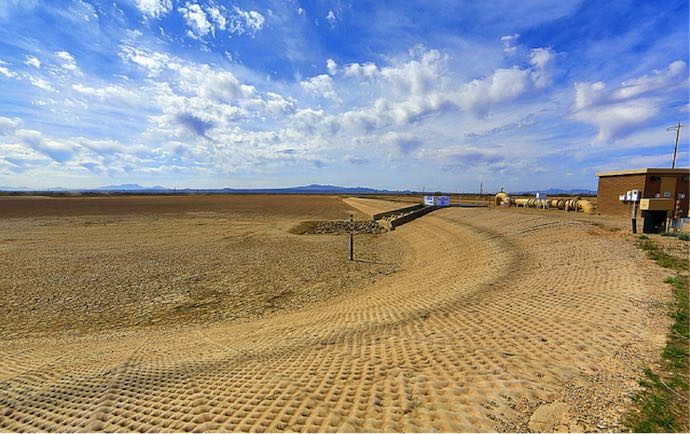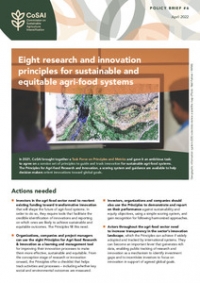Groundwater is arguably the most important aspect of our collective water security in the 21st century. Farmers draw upon it as a sort of water insurance policy when the rains falter, or when surface supplies prove inadequate. But we take it for granted, in part because — historically speaking — groundwater has been essentially invisible beneath our feet until very recently.
With the advent of satellite-based remote-sensing technology, we now have grown increasingly aware this crucial water resource is in serious danger, and being pumped far faster than it can recharge in many parts of the world. To improve our resiliency to a shifting climate and extend our growing seasons, we must seriously consider not just pumping groundwater to the surface, as we have always done, but also storing today’s surface waters underground to ensure our water security for tomorrow.
 An empty groundwater recharge basin outside of Tucson, Arizona, United States.
An empty groundwater recharge basin outside of Tucson, Arizona, United States.Photo: Bill Morrow on Flickr
Enter the long-discussed but little-implemented intervention that could go a long way toward bolstering water-supply resiliency in arid and semi-arid regions — underground water storage.
How does it work?
Underground water storage — also known as managed aquifer recharge — is the process of purposefully refilling aquifers with surface water in order to more effectively manage water supply. This can be achieved by either directly injecting surface waters into aquifers via wells, or by filling recharge basins (such as the one pictured above) that allow surface waters to slowly percolate downwards into the groundwater table below.
In the state of Arizona in the southwestern United States, aquifer recharge has already emerged as important tool to battle chronic water scarcity. In 2006, for example, the state’s Tonopah Desert Recharge Project became operational, with a goal of storing 185 million cubic meters of water annually. Using 19 recharge basins spread out across 83 hectares, the project allowed surface waters to slowly refill the underlying aquifer, with progress measured by monitoring wells.
Within three years, the operation had successfully stored 600 million cubic meters of water underground, exceeding expectations and improving the area’s water security. When water was required again at the surface for irrigation or municipal use, wells and pipelines were used to pump the recharged groundwater as needed. Those supplies could then be transferred elsewhere in the region via a nearby canal.
Pilot studies are currently exploring the applicability of underground water storage in other drought-prone parts of the world. To date, experts and development practitioners are confident the technology has the potential to be significantly scaled-up in many regions, although the effectiveness of underground storage varies according to soil composition and the type of aquifer in a given region.
For Karen Villholth, a groundwater management specialist for the International Water Management Institute (IWMI) in South Africa, underground storage “could play a significant role in semi-arid and arid parts of Africa — such as Botswana and South Africa — where episodically heavy rains occur, and where surface water storage and transfer options are exhausted.”
Meanwhile, many research initiatives and pilot projects are also now pushing the envelope of underground storage technology and exploring its potential suitability for locations as diverse as India, the United States, Thailand, Australia, Central Asia, and even small island states like the Maldives.
“In principle, there are possibilities to enhance underground storage in many geological settings,” says Vladimir Smakhtin, theme leader on water availability and access for IWMI. “The extent of course will differ.”
Climate change and the need for better water storage
As climate change makes seasonal precipitation and surface flows increasingly erratic, the need for improved storage techniques has become more acute than ever. Experts agree storing water underground is far more efficient than storing water in surface reservoirs. This is because storing water underground minimizes evaporation, which is a major cause of water loss in surface reservoirs in arid and semi-arid climates.
Underground storage can accommodate far greater variability in demand from farmers, particularly during drought or the dry season when irrigation water may be needed most. “It can help greatly in improving water use efficiency in both rain-fed areas and in irrigation areas by helping to better match water availability with demand,” says Paul Pavelic, a hydrogeological expert and groundwater specialist with IWMI.
Pavelic says recharging aquifers with wet season rain bolsters water security by offering “protection against climate variability” by making groundwater available “where and when it is needed.” Rural livelihoods during the dry season stand to improve as a result. By providing additional groundwater for irrigation, recharged aquifers mean “farmers can increase the number of cropping seasons,” adds Brindha Karthikeyan, a surface and groundwater specialist with IWMI’s Laos office.
What other policy measures or infrastructure investments might be combined with underground storage to more effectively use groundwater in a sustainable manner and improve our climate resiliency?















Comments
This essentially referes to rain water harvesting & recharging. We, as a water management consultants, have successfully recharged underground aquifers as is evident from the corresponding shallowing of the water table in the surrounding areas and also overall improvement in the water quality.
The challenge though is limited awareness and lack of vision among the common mass about augured water crisis and project implementation being handled by people who neither have any subject knowledge nor have a will to do a good job!
aquifer storage & recovery (ASR) as we term it in Colorado is a proven and viable technology. We have used it in our deep well aquifers since 1991. We run in to the same perceptions of either not understanding the looming water shortage or not willing to invest in something unseen. It is time we beat the drum for this technology and I appluad your efforts.
Managed Aquifer Recharge systems should be a must everywhere. We keep drawing water from our underground reserves, like we could never run out of that very valuable resource. Most of the people, do not understand the importance of these systems and indeed, we need to start make them aware of the problem and that this is an important part of the solution. Not only is it important in arid or semi arid areas. Even the tropics, where we do most of our work, need to have the aquifers recharged, as right now, we are drawing more from them, than their capacity to recharge on their own natural means.
Congratulations to every person who has embarked in this topic.
Storing water underground is an interesting idea. I remember finding out when I was little than water ran beneath our feet in the ground. I couldn't believe it! It's important to store our water in an accessible area so that it can be easy to get to in an emergency. https://www.watertectucson.com
My question is that in our area we have arsenic and thought about recharging our aquifer but will the water we capture and put in the aquifer also have arsenic once it is mixed together? We are looking for alternatives to a reverse osmosis to remove arsenic and have even considered an experiment that is currently in florida using cactus, a product we have in abundance in south texas.
it's very useful.. i'm looking to implement in my home town , a small village where we are suffering from water scarcity ...
rgds/manish trivedi
I live in a less than 200 m3/person/year water disponibility city, about 700 to 1,000 mm/year rainfall. Such a system would be of much interess where 70% comes from underground water with a very high overexploted rate of wells. Please contact me as a water specialist and consultant of even the autorities or private sectors.